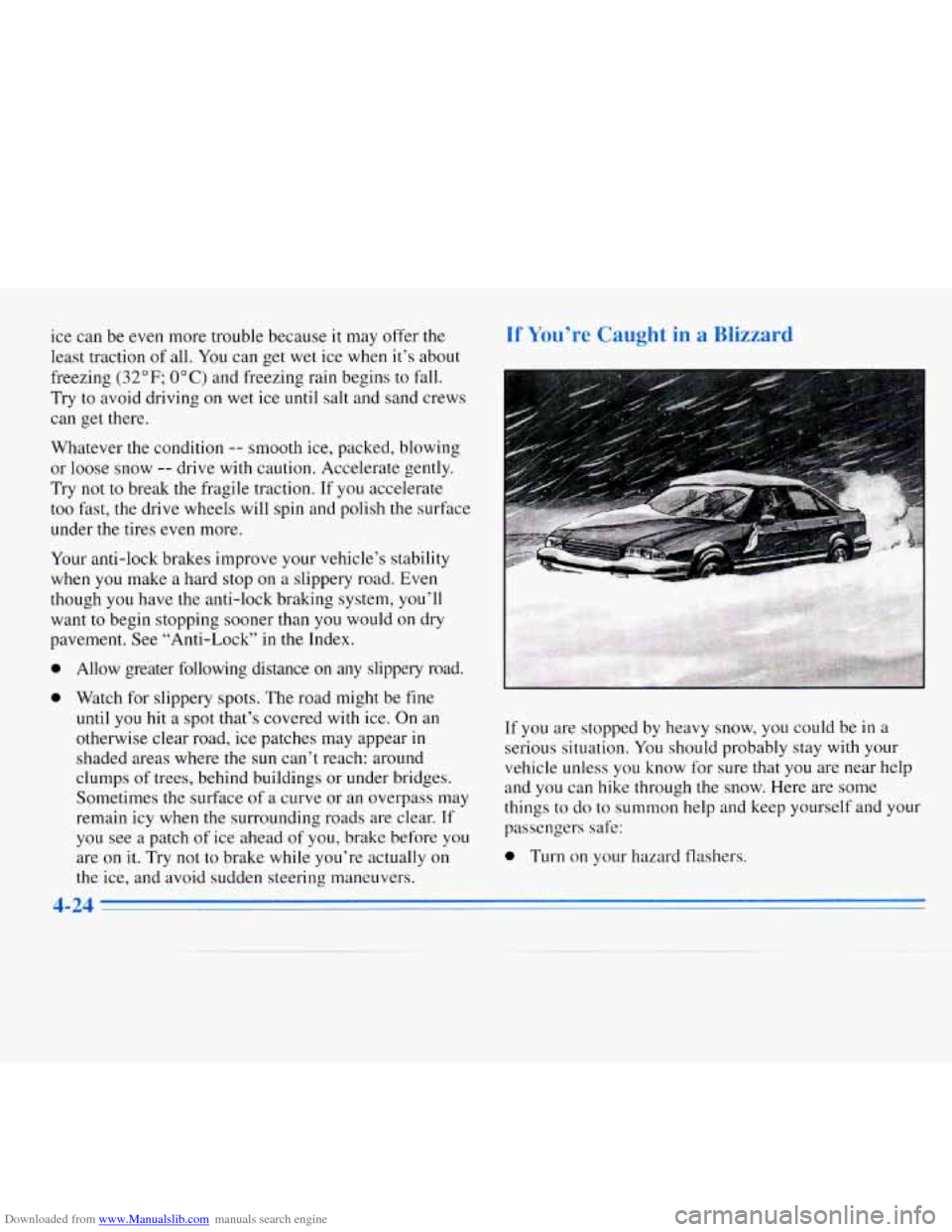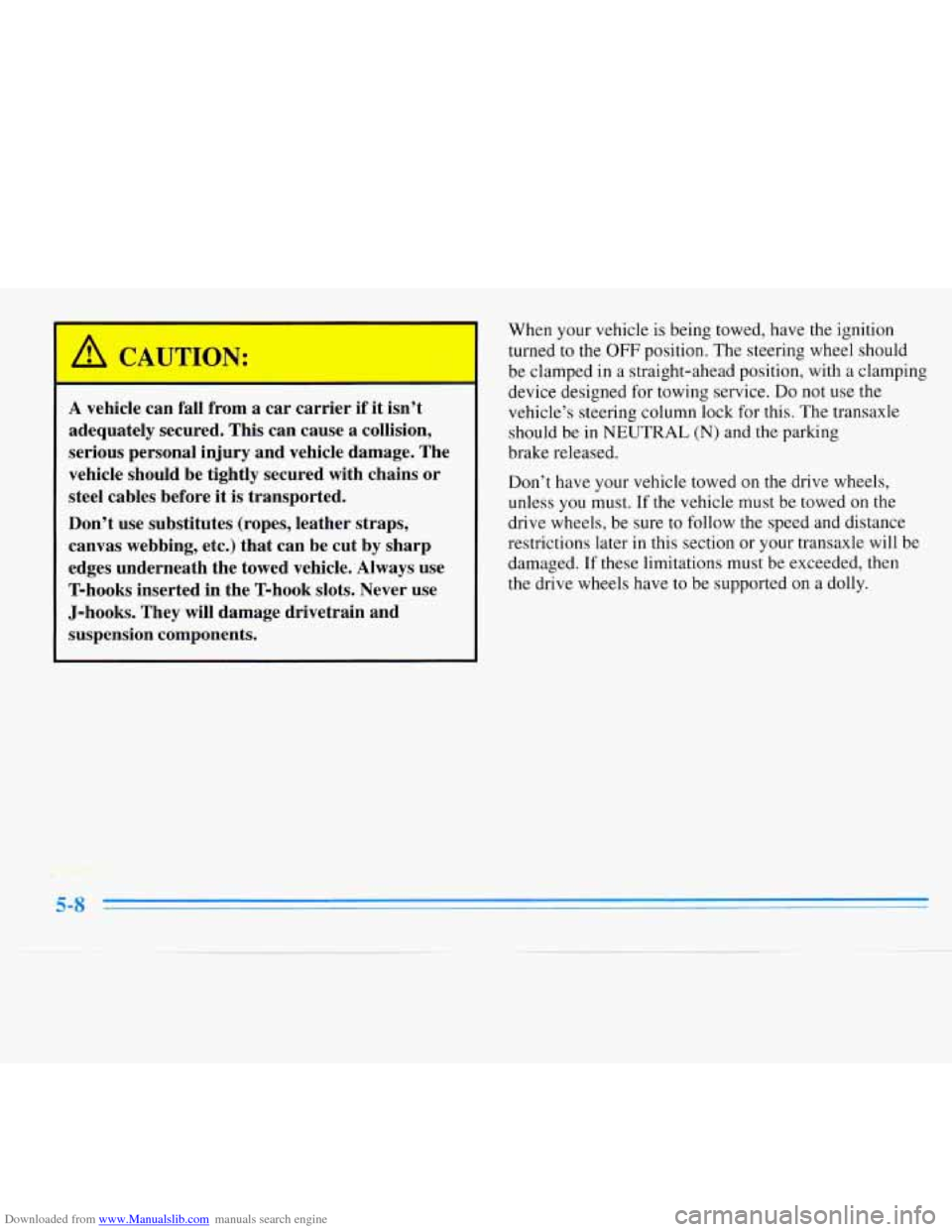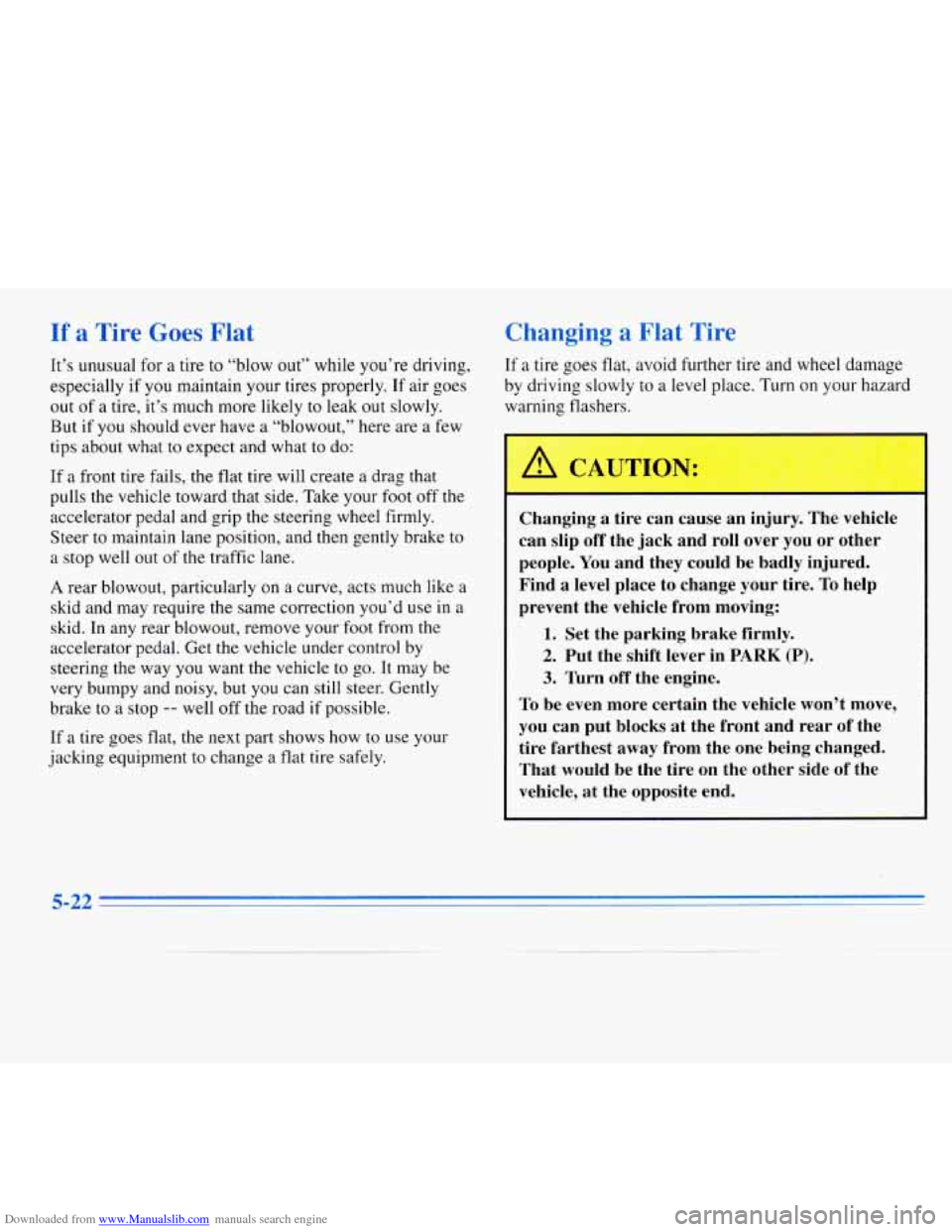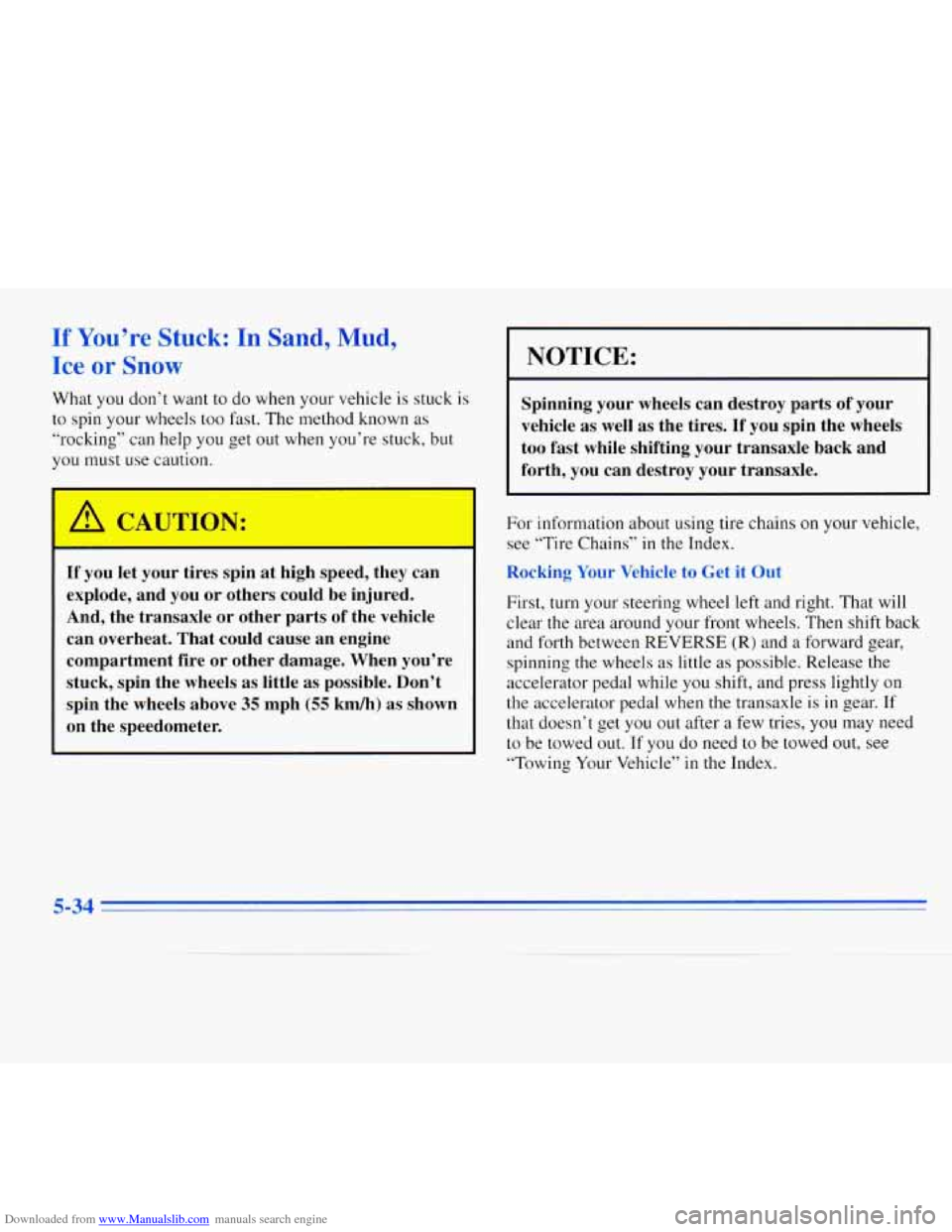Page 160 of 340

Downloaded from www.Manualslib.com manuals search engine ice can be even more trouble because it may offer the
least traction of all. You can get wet ice when it’s about
freezing
(32°F; OOC) and freezing rain begins to fall.
Try to avoid driving on wet ice until salt and sand crews
can get there.
Whatever the condition
-- smooth ice, packed, blowing
or loose snow
-- drive with caution. Accelerate gently.
Try not to break the fragile traction.
If you accelerate
too fast, the drive wheels will spin and polish
the surface
under the tires even more.
Your anti-lock brakes improve your vehicle’s stability
when
you make a hard stop on a slippery road. Even
though you have the anti-lock braking system, you’ll
want to begin stopping sooner than you would on dry
pavement. See “Anti-Lock” in the Index.
0
0
Allow greater following distance on any slippery road.
Watch for slippery spots. The road might be
fine
until you hit a spot that’s covered with ice. On an
otherwise clear road, ice patches may appear
in
shaded areas where the sun can’t reach: around
clumps
of trees, behind buildings or under bridges.
Sometimes the surface
of a curve or an overpass may
remain icy when the surrounding roads are clear. If
you see
a patch of ice ahead of you, brake before you
are on it. Try not
to brake while you’re actually on
the ice, and avoid sudden steering maneuvers.
.ght i a. 122 -..
If you are stopped by heavy snow, you could be in a
serious situation.
You should probably stay with your
vehicle unless
you know for sure that you are near help
and you can hike through the snow. Here are some
things to do to summon help and keep yourself and your
passengers
safe:
0 Turn on your hazard flashers.
Page 168 of 340

Downloaded from www.Manualslib.com manuals search engine Trailer Brakes Following Distance
Because
you have anti-lock brakes, do not try to tap into
your vehicle’s brake system. If you do, both brake
systems won’t work well, or at all.
Driving with a Trailer
Towing a trailer requires a certain amount of experience.
Before setting out for the open road, you’ll want to get
to
know your rig. Acquaint yourself with the feel of
handling and braking with the added weight
of the
trailer. And always keep in mind that the vehicle you are
driving
is now a good deal longer and not nearly as
responsive as your vehicle is by itself.
Before you start, check the trailer hitch and platform
(and attachments), safety chains, electrical connector,
lamps, tires and mirror adjustment.
If the trailer has
electric brakes, start your vehicle and trailer moving and
then apply the trailer brake controller by hand to be sure
the brakes are working. This lets you check your
electrical connection at the same time. Stay
at least twice as far behind me vehicle ahead
as you
would when driving your vehicle without a trailer. This
can help you avoid situations that require heavy braking
and sudden turns.
Passing
You’ll need more passing distance up ahead when
you’re towing
a trailer. And, because you’re a good deal
longer, you’ll need to go much farther beyond the
passed vehicle before you can return to your lane.
Backing Up
Hold the bottom of the steering wheel with one hand.
Then, to move the trailer to the left, just move that hand
to the left.
To move the trailer to the right, move your
hand to the right. Always back up slowly and, if
possible, have someone guide you.
During your trip, check occasionally
to be sure that the
load is secure, and that
the lamps and any trailer brakes
are still working.
4-32
Page 180 of 340

Downloaded from www.Manualslib.com manuals search engine A vehicle can fall from a car carrier if it isn’t
adequately secured. This can cause a collision,
serious personal injury and vehicle damage. The
vehicle should be tightly secured with chains or
steel cables before it is transported.
Don’t use substitutes (ropes, leather straps,
canvas webbing, etc.) that can be cut by sharp
edges underneath the towed vehicle. Always use
T-hooks inserted in the T-hook slots. Never use
J-hooks. They will damage drivetrain and
suspension components.
When your vehicle is being towed, have the ignition
turned to the
OFF position. The steering wheel should
be clamped in a straight-ahead position, with a clamping
device designed for towing service. Do not
use the
vehicle’s steering column lock for this. The transaxle
should be
in NEUTRAL (N) and the parking
brake released.
Don’t have your vehicle towed on the drive wheels,
unless you must. If the vehicle must be towed on the
drive wheels, be sure to follow the speed and distance
restrictions later in this section or your transaxle will be
damaged.
If these limitations must be exceeded, then
the drive wheels have
to be supported on a dolly.
Page 194 of 340

Downloaded from www.Manualslib.com manuals search engine If a Tire Goes Flat
It’s unusual for a tire to “blow out7’ while you’re driving,
especially if
you maintain your tires properly. If air goes
out of a tire, it’s much more likely
to leak out slowly.
But if you should ever have a “blowout,” here are a few
tips about what to expect and what to do:
If a front tire fails, the flat tire will create a drag that
pulls
the vehicle toward that side. Take your foot off the
accelerator pedal and grip the steering wheel firmly.
Steer
to maintain lane position, and then gently brake to
a stop well out of the traffic lane.
A rear blowout, particularly on a curve, acts much like a
skid and may require the same correction you’d use in a
skid. In any rear blowout, remove your foot from the
accelerator pedal. Get the vehicle under control by
steering the way you want the vehicle to go. It may be
very bumpy and noisy, but you can
still steer. Gently
brake to a stop
-- well off the road if possible.
If
a tire goes flat, the next part shows how to use your
jacking equipment to change a flat tire safely.
Changing a Flat Tire
If a tire goes flat, avoid further tire and wheel damage
by driving slowly to a level place. Turn
on your hazard
warning flashers.
L
Changing a tire can cause an injury. The vehicle
can slip off the jack and roll over you
or other
people. You and they could be badly injured.
Find a level place to change your tire.
To help
prevent the vehicle from moving:
1. Set the parking brake firmly.
2. Put the shift lever in PARK (P).
3. Turn off the engine.
To be even more certain the vehicle won’t move,
you can put blocks at the front and rear of the
tire farthest away from the one being changed.
That would be the tire on the other side of the
vehicle, at the opposite end.
Page 206 of 340

Downloaded from www.Manualslib.com manuals search engine If You’re Stuck: In Sand, Mud,
Ice or Snow I NOTICE:
What you don’t want to do when your vehicle is stuck is
to spin your wheels too fast. The method known
as
“rocking” can help you get out when you’re stuck, but
you must use caution.
Spinning your wheels can destroy parts of your
vehicle as well as the tires.
If you spin the wheels
too fast while shifting your transaxle back and
forth, you can destroy your transaxle.
If you let your tires spin at high speed, they can
explode, and you or others could be injured.
And, the transaxle
or other parts of the vehicle
can overheat. That could cause an engine
compartment fire
or other damage. When you’re
stuck, spin the wheels as little
as possible. Don’t
spin the wheels above
35 mph (55 km/h) as shown
on the speedometer.
For information about using tire chains on your vehicle,
see “Tire Chains”
in the Index.
Rocking Your Vehicle to Get it Out
First, turn your steering wheel left and right. That will
clear the area around your front wheels. Then shift back
and forth between REVERSE
(R) and a forward gear,
spinning
the wheels as little as possible. Release the
accelerator pedal while you shift, and press lightly on
the accelerator pedal when the transaxle is
in gear. If
that doesn’t get you out after
a few tries, you may need
to be towed out.
If you do need to be towed out, see
“Towing Your Vehicle”
in the Index.
5-34
Page 215 of 340
Downloaded from www.Manualslib.com manuals search engine When you open the hood on the 3.1 L L82 (Code M) engine, you’ll see:
A. Engine Coolant Reservoir
B. Radiator Fill Cap
C. Power Steering Fluid Reservoir
D. Engine Oil Fill Cap
E. Engine
Oil Dipstick
E Automatic Transaxle Dipstick
G. Brake Fluid Reservoir
H. Air Cleaner
I. Windshield Washer Fluid Reservoir
J. Batte~y (located under Windshield Washer Reservoir)
Page 216 of 340
Downloaded from www.Manualslib.com manuals search engine !i
When you open the hood on the 3.4L LQ1 (Code X) engine, you’ll see:
A. Engine Coolant Reservoir
B. Radiator Fill Cap
C. Power Steering Fluid Reservoir
D. Engine Oil Fill Cap
E. Engine Oil Dipstick
E Automatic Transaxle Dipstick
G. Brake Fluid Reservoir
H. Air Cleaner
I. Windshield Washer Fluid Reservoir
J. Battery (located under Windshield Washer Reservoir)
6-8 II
Page 231 of 340

Downloaded from www.Manualslib.com manuals search engine Radiator Pressure Cap Power Steering Fluid
NOTICE:
Your radiator cap is a 15 psi (105 kPa)
pressure-type cap and must be tightly installed
to prevent coolant
loss and possible engine
damage from overheating. Be sure the arrows
on the cap line up with the overflow tube on
the radiator filler neck.
When you replace your radiator pressure cap, an AC@
cap is recommended.
Thermostat
Engine coolant temperature is controlled by a thermostat
in the engine coolant system. The thermostat stops the
flow of coolant through the radiator until the coolant
reaches a preset temperature.
When you replace your thermostat, an AC@ thermostat
is recommended.
3.1L L82 (Code M) Engine 3.4L LQI (Code X) Engine
When to Check Power Steering Fluid
It is not necessary to regularly check power steering
fluid unless you suspect there is a leak
in the system or
you hear an unusual noise. A fluid loss-in this system
could indicate a problem. Have the system inspected
and repaired.
6-23